Alleviation: An International Journal of Nutrition, Gender & Social Development, ISSN 2348-9340
Volume 3, Number 3 (2016) : 32-36
©Arya PG College, Panipat & Business Press India Publication, Delhi
www.aryapgcollege.com, www.apcjournals.com
Designing and Creation of Bed Room Linens Inspired from Warli Motifs by Using Tie and Dye with Screen Printing
Sonika Kumari
Guest Faculty, Department of Home Science, Arya PG College, Panipat
(Haryana), India
Email: sonika.attri892@gmail.com
Introduction
Due to diversified talents, interests and inspiration, each state in India has its special identity for its unique folk painting, traditional embroideries and various printing techniques. In India, handicrafts have an importance on their own. Folk art and craft are important part of our life as they are closely intermingled with our everyday life in terms of objects which we use in the home, in our festivals, ceremonies and rituals and also means of self expression. Paintings of India have adopted various techniques and styles on their journey into the art world. There are different types of tribal and folk paintings all over India. Each style is different from the other. Warli paintings are an ancient art, evolved in Maharashtra, India, in between 2500 to 3000 BC. The word ‘Warli’ comes from the “Warla” meaning a piece of land or a field. Warli paintings are made on the walls expressing everyday life using extremely basic object forms and just one color, i.e. white on an austere mud base. In present time, these traditional paintings are also used for textile decoration, which would serve as a dual purpose of introducing something new to this world of fashion and helping to brush off the dust from the traditional and beautiful art. Most widely accepted and traditional method of printing textiles in India is the art of tie and dye. It is also known as “Bandhani” derived from the word “Bandhan” that means to tie. It is a type of resist dyeing. This technique involves dyeing a fabric which is tied tightly with a thread, a rubber band, a rope, a string and raffia at several points, thus producing a variety of patterns like stripes, circles, spiral and shapes depending on the manner in which the cloth is tied. Much time and expense is lavished on textiles for no better reason than variety and love for beauty. In selection of bed room linens; attractiveness, suitability and serviceability are the qualities which are considered primarily by majority of consumers. For printing bed room linens, a method adopted should produce bulk production involving less labor and time. It can be screen printing and stencil printing. Screen printing when compared with other techniques gives much better effects.
The present study “Designing and Creation of Bed Room Linens Inspired from Warli Motifs by Using Tie and Dye with Screen Printing” has been inspired from Warli motifs and these motifs are used for making designs for bed room linens. The everlasting charm of tie and dye with screen printing with a wide array of medley of Warli motifs gives a wide scope of creating aesthetically beautiful designs. The researcher has undertaken above mentioned study with the following objectives:
1) To design contemporary bed room linens with combination of Warli motifs, Tie & Dye and Screen Printing.
2) To construct two most preferred designs of bed room linens.
3) To check the market acceptability and consumer acceptability of bed room linens.
Methodology
Development of Designs
Design development was carried out in following steps:
Selection of fabric for bed linens: The material choice was related to the end use of the product. A market survey was conducted to find out the availability of various types of fabrics suitable for bed room linens. Different materials suitable for dyeing and printing were collected which included cotton, glaze cotton, chanderi, and taffeta. These samples were visually evaluated.
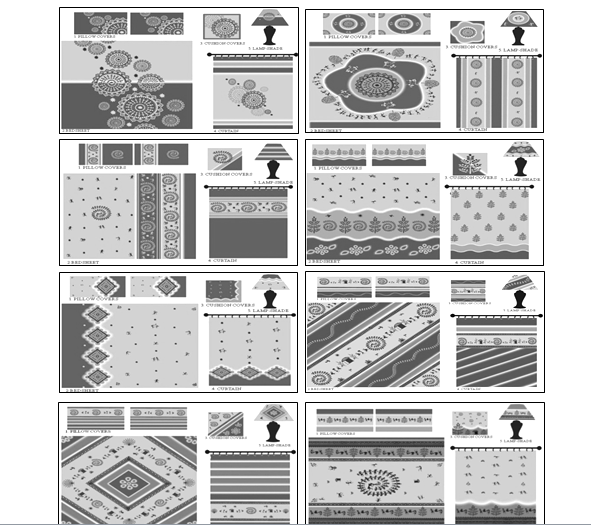
Fig 1: Designs for Bed Room Linens
Evaluation of color schemes for tie and dye: For the selection of colors for tie and dye, only secondary and tertiary colors were used. Different possible color ways were developed under each color scheme and two best combinations from each color scheme were selected. Further the samples were developed using selected combinations along with Warli motifs to select the final color combinations.
Designing of bed room linens: The main aim of the study was to create bed room linens which included a bedspread, pillow covers, cushion covers, curtains and lamp shades. Total 10 designs were created. Base designs for linens with different effects of tie and dye were created by using the computer software Adobe Photoshop 0.7. The Warli motifs were made on Corel Draw 12.
Assessment of color fastness: All test specimens for preliminary tests and specific tests were done according to procedure outlined by ISI for physical tests. After performing various tests, the change in the color of the direct samples and the staining of the white material was evaluated against Grey Scale. Evaluation was carried out for fastness of color to sunlight, washing and rubbing/crocking.
Evaluation and statistical analysis of designs: The designs of bed linens were evaluated by a panel of judges having knowledge of principles and elements of design. The judges were asked to rank each design in order of preferences. The design that got the highest score was considered the most preferred design. Collected data were analyzed statistically.
Construction of Bed Room Linens
The two most preferred designs with selected color schemes were made through the techniques of tie and dye combined with screen printing.
Costing of Bed Room Linens
The cost of bed room linens were estimated by adding the cost of fabric, colors, screens and trims used and also labor charges and 20 per cent of profit was also added to the cost.
Marketability and Consumer Acceptability of Bed Room Linens
Marketability of the bed room linens was checked by surveying leading retail shops of Chandigarh dealing in household linens. A questionnaire was prepared and responses were noted down from the owners of the shops.
Results and Discussion
Selection of Fabric for Bed Room Linens
The choice of the material was related to the end use of the product. Glaze cotton fabric was selected for bed sheets, pillow covers and cushion covers and chanderi fabric was selected for curtains and lamp shades as they have good absorbency for dyes.
Selection of Color Schemes Used for Samples
Different possible color ways were developed under each color scheme and two best combinations from each color scheme were selected. Top two ranked color ways from each color scheme were selected to print with Warli motifs. Thus monochromatic color schemes (Blue-green and yellow-green) were selected for final product.
Color Fastness
It can be seen from the Table 1 that almost all the dyed samples had excellent color fastness with regard to color change as well as staining. Dyed samples showed excellent color fastness to sunlight, washing and crocking as there was no change in color.
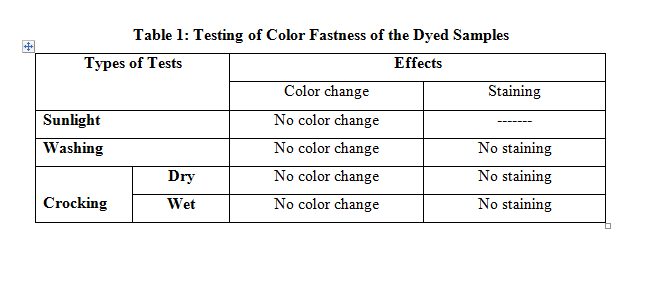
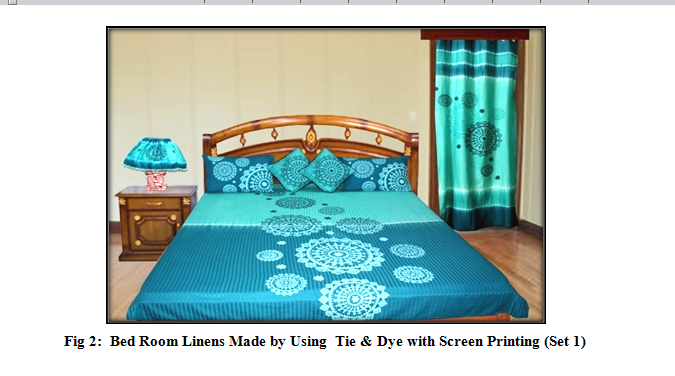
Costing of Created Bed Room Linens
It is visible from the Table 2 that after adding 20 per cent profit, the cost of the bed room linens was estimated to be Rs. 4080/ for Set 1 (Fig 2) and Rs. 3,870/ for Set 2 (Fig 2).
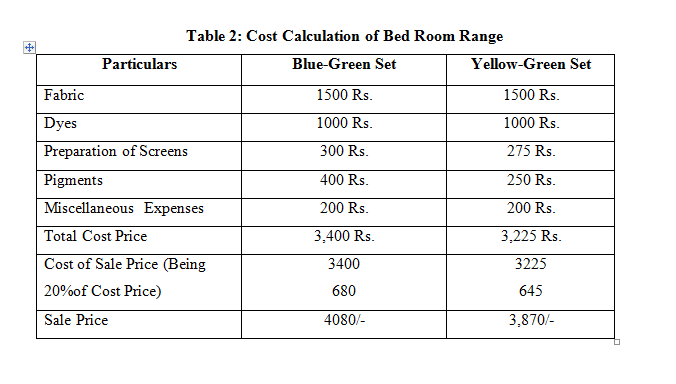
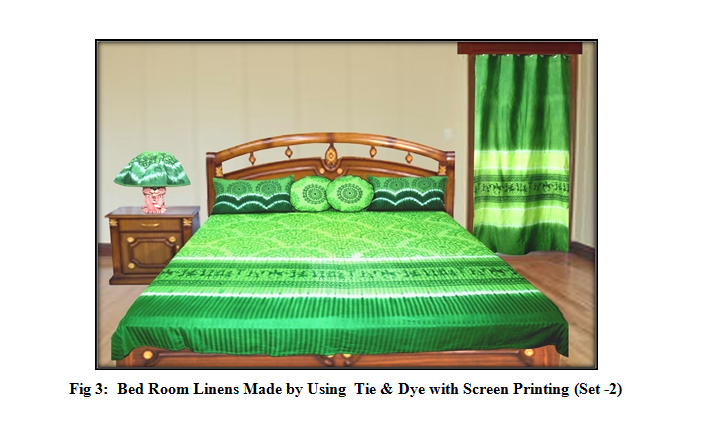
Market Acceptability of Bed Room Linens
A survey was conducted to check the market acceptability of the bed room linens, the quoted price was Rs. 4080/-for blue-green set and Rs. 3,870/- for yellow green set. It is highlighted in the Table 3 that 80 per cent of shop owners were interested in placing the order for bed linens as they found the designs very interesting and rate was reasonable whereas 20 per cent of them did not want to place the order as they wanted only to sell their own products or specific brand products.
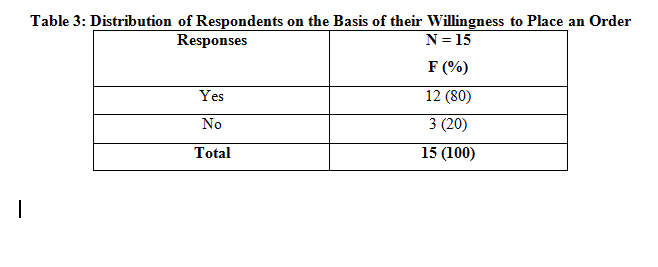
Conclusions
The study showed that bed room linens prepared with tie and dye in combination with screen printing with a wide variety of Warli motifs are acceptable in the market. It can be concluded that the rich treasure of traditional art can be given shape to the modern art by creating aesthetically beautiful designs by combing different techniques of dyeing and printing.
References
Indu (2009) Creation of Designs Inspired from Lotus Motif for Textile Printing, M.Sc Dissertation (Unpublished), Panjab University, Chandigarh.
Sunetra D (2010) Evaluation of Bandhani Motifs and Processes of Rajasthan: From Past to Contemporary, M.Sc Dissertation (Published), The IIS University, Jaipur.
Arora S (2011) Designing and Creation of Household Linens Inspired from Turkish Motifs Using Screen Printing, M.Sc Dissertation (Unpublished). Chandigarh: Panjab University.

